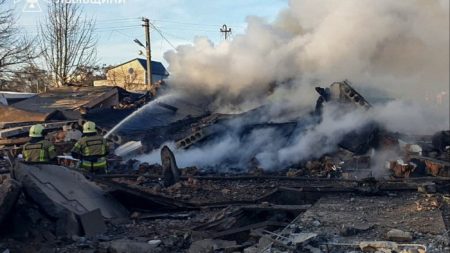The destruction of the Kakhovka dam and power plant that unleashed floodwater across southern Ukraine is likely to limit Kyiv’s options in its incipient counter-offensive, according to military officials and analysts.
Moscow and Kyiv traded blame on Tuesday for the demise of the dam, which spanned the Dnipro river and is located in Russian-occupied Kherson province.
Kremlin spokesperson Dmitry Peskov claimed it was a “deliberate act of sabotage by the Ukrainian side aimed at depriving Crimea of water” and intended to distract from the “stuttering Ukrainian offensive”.
But Ukrhydroenergo, Ukraine’s state-owned hydropower company, said an explosion inside the engine room had demolished the dam, while President Volodymyr Zelenskyy said “Russian terrorists” were at fault.
“It is physically impossible to blow it up somehow from the outside — with shelling. It was mined. It was mined by the Russian occupiers and blown up by them,” he said. “Russia detonated a bomb of mass environmental damage. This is the biggest man-made environmental disaster in Europe in decades.”
Neither claim could be immediately verified.
But some military analysts and Ukrainian officials say the timing of the dam’s destruction is suspicious, as it largely benefits Russia, by scuppering Kyiv’s plans to attack to the south and increasing the likelihood of an eastward offensive that Moscow could focus on. Russian forces have failed to make any significant battlefield advances this year after announcing an offensive in January.
“The purpose is obvious: to create insurmountable obstacles in the way of the advancing Ukrainian armed forces,” said Mykhailo Podolyak, a top adviser to Zelenskyy.
Footage shared on social media showed water swallowing the destroyed dam and flooding towns and villages along the banks of the Dnipro river. Ukrainian authorities rushed to evacuate tens of thousands of residents in government-controlled areas affected by the flood.
Ukraine is expected to launch an assault in the south to try to break through and sever the “land bridge” connecting Russian territory with the occupied Zaporizhzhia and Kherson provinces, as well as the Crimean peninsula, which Russia annexed in 2014. The connection is crucial for Russian military logistics and supplies. If Kyiv were to reach the strategic city of Melitopol or all the way to the Sea of Azov, it would deal a huge blow to Russia’s southern occupation and its forces’ morale.
Russia’s likely involvement pointed to its fears of the upcoming Ukrainian counteroffensive, said Pavel Luzin, a visiting scholar at Tufts University’s Fletcher School of Law and Diplomacy.
He said that the dam’s construction — an earth fill dam, made of compacted soil — meant it could only have been blown up from the inside and would have been left largely undamaged by artillery strikes.
“They spent all of May trying to stop the attack with more missile attacks. It didn’t work, so they decided to blow up a power station,” Luzin said.
But Russia’s positions would likely be worse affected than Ukraine’s in the longer term, he added. “The water will flow away in a few days, and it’s the Russian positions on the left bank that are flooded,” he said.
The dam breach came as Ukrainian forces in recent days stepped up assaults at multiple locations along the 1,000km frontline in the country’s south and east, signalling that the long-awaited counteroffensive was possibly getting under way.
Ukraine’s defence ministry reported on Tuesday that its forces had seized more territory near the Donbas city of Bakhmut, which was fully captured by Russian troops and Wagner mercenaries in May after 10 months of gruelling fighting and remains the “epicentre” of the fighting.
“Russia benefits from the frontline being smaller because it is easier to concentrate forces to prevent a breakthrough,” said Rob Lee, senior fellow at the Foreign Policy Research Institute, a US think-tank. “So if a Ukrainian operation in Kherson is less likely now, they might be able to move more forces east.”
A Ukrainian military official speaking on condition of anonymity said officials were assessing the damage caused by the flooding and would adjust their counteroffensive plans accordingly.
“If we had any plans for a landing operation there, we definitely won’t do it anytime soon,” they said. “Immediately after [the flooding], the land will be a marsh, essentially.”
Andriy Zagorodnyuk, a military adviser and former Ukrainian defence minister, said it was likely that Kyiv’s generals “have alternative plans”. The flooding may be a setback, he said, but it won’t stop Ukraine’s counter-offensive.
“If we wanted to cross the river there, it’s not going to happen,” he added. “Basically, it denies any ability for us to cross the river and move equipment in that area. Essentially, that’s why most likely Russia did it, particularly now.”
Ukraine’s Centre for Strategic Communication and Information Security, a government unit, said it was possible Russian forces blew up the dam to flood islands downstream, which it said had been recaptured by Ukrainian troops on Monday.
“Another likely reason is the desire to inflict maximum damage on Ukraine in conditions where the occupiers have lost hope of maintaining their control over the south of Ukraine,” it added.
The flooding, said a western official, “will affect large swaths of civilian infrastructure which is hard to regenerate in the middle of a war. If you widely advertise that you are about to embark on a counteroffensive, you should also not be surprised if opponents take countervailing measures.”
But the flooding affects Russian forces, too. “The destruction of the dam floods the first Russian line of defence east of the Dnipro river in Kherson, though the threat of a Ukrainian river crossing was always low,” said Michael Kofman, a military analyst at the Center for Naval Analyses, a Washington-based think-tank. “This disaster benefits nobody, and will affect Russian-occupied territory the most.”
Russia’s military bloggers, who fervently support the war but have criticised the army’s leadership, largely backed the official version of events.
“It’s our left bank that suffers more from the flooding. It doesn’t make sense why we’d do this,” wrote Alexander Kots, a Russian war reporter for pro-Kremlin tabloid Komsomolskaya Pravda.
But some could not help delighting in the difficulties the dam’s collapse created for Ukraine’s counteroffensive in the region.
“I won’t say who blew it up or evaluate it in any way,” said Egor Guzenko, a Russian volunteer fighter and blogger. “But from a tactical point of view, [Ukraine] can forget about an offensive in Kherson.”
Additional reporting by John Paul Rathbone in London
Read the full article here













